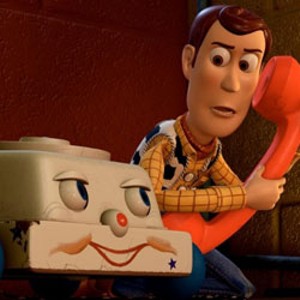Published June 23, 2010 at 6:45 a.m.
So you think Toy Story movies are fun and games? Think again. The villain of this third installment in the immensely popular Pixar series is a cuddly, strawberry-scented stuffed animal named Lots ’o Huggin’ Bear (Lotso for short, voiced by Ned Beatty) whose view of the world is “We’re all trash.” Call him a materialist nihilist.
Sure, when it comes down to it, toys are trash. But they’re also the repositories of kids’ fears and fantasies. We see that at the film’s opening, when young Andy (Charlie Bright) acts out a wild Western-slash-science-fiction scenario with his beloved Woody (Tom Hanks), Buzz Lightyear (Tim Allen) and the rest of the gang. After we watch his tall tale unfold in Technicolor, the action shifts to the real world (or a 3-D computer-animated simulation of it), where the boy quickly ages into a college-bound young man. Will Andy’s precious toys end up in the attic or the landfill? And can they trust him to make the right choice?
Woody, a loyalist to the principles of family and private property, believes they can. (He’s like one of those old-time English butlers who refuses to hear a bad word about the gov’nor.) Jessie the cowgirl (Joan Cusack) is more of a maverick. She thinks the crew might be better off donated to a daycare center, where they’ll never lack children to play with them.
At the daycare, though, the toys’ dream of collective ownership gives way to the reality of brutal toddler play and a prison-like toy regime presided over by Lotso and his henchmen, who include a sparkly purple octopus and a preening Ken doll. Talk about harsh lessons.
And you don’t need a PhD to apply them to humans. For the past three years, Pixar has given us incredibly wrenching animated fantasies about things or people — it doesn’t really matter which — that are discarded, forgotten, left behind. In WALL-E, a robot was the last guardian of a trashed Earth. In Up, an old man’s house, dwarfed by skyscrapers, embodied his deferred dreams. When WALL-E brought humanity back home, when the codger’s house became airborne, we all felt reassured that people and their imaginations are not trash destined for some cosmic landfill.
In Toy Story 3, those terrors play out on a smaller scale — though a sequence set in a garbage-processing plant evokes Dante’s Inferno. The toys’ fears about being dumped by the one who loved and nurtured them plug into kids’ fears of parental abandonment. One flashback is almost as painful to watch as the death of Bambi’s mom. Which isn’t to say kids shouldn’t see the movie — hey, each new generation needs its own Disney-induced trauma.
A better reason for them to see Toy Story 3: When it’s not sad, it’s funny. Yes, heroes Woody and Buzz are pretty square, and some of the humor relies on stereotypes, such as giggly Barbie’s “meet cute” with effeminate Ken, or Buzz going into a suave Spanish-language mode. But then the movie throws you for a loop: Barbie suddenly quoting the Declaration of Independence; a vintage Fisher-Price Chatter Phone showing up and talking like a seasoned convict in a prison film.
It’s pretty clear the folks at Pixar are of the same general vintage as that phone, and they’re feeling their age. But they pack the film with visual riches, and the wordless short that precedes it, “Day & Night,” has some of the beauty of Disney’s Fantasia. Come for the joyful kid stuff, but be warned, these animators don’t play around.
Info:
More By This Author
Speaking of Movies, movie Review
-

Next Month Brings the Final Curtain for Palace 9 Cinemas
Oct 27, 2023 -

Book Review: 'Save Me a Seat! A Life With Movies,' Rick Winston
Aug 30, 2023 -

Steve MacQueen Named Executive Director of Vermont International Film Festival
May 22, 2023 -

Vermonters Are Going Back to the Movies — Under the Stars
Aug 26, 2020 -

Where to Catch a Movie Near Burlington
Sep 11, 2018 - More »
Comments
Comments are closed.
From 2014-2020, Seven Days allowed readers to comment on all stories posted on our website. While we've appreciated the suggestions and insights, right now Seven Days is prioritizing our core mission — producing high-quality, responsible local journalism — over moderating online debates between readers.
To criticize, correct or praise our reporting, please send us a letter to the editor or send us a tip. We’ll check it out and report the results.
Online comments may return when we have better tech tools for managing them. Thanks for reading.












































